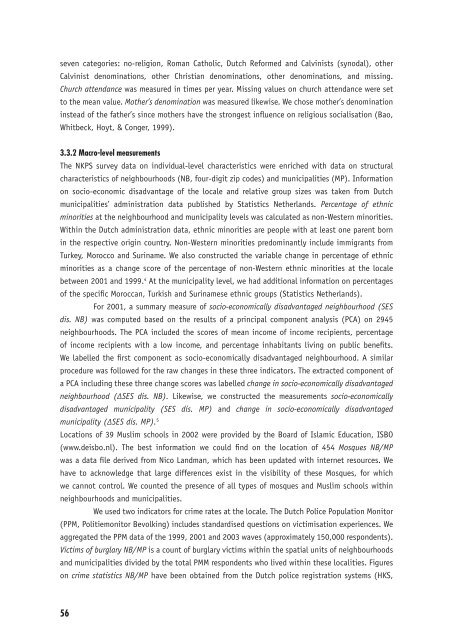Ethnic Hostility among Ethnic Majority and Minority Groups
Ethnic Hostility among Ethnic Majority and Minority Groups
Ethnic Hostility among Ethnic Majority and Minority Groups
Create successful ePaper yourself
Turn your PDF publications into a flip-book with our unique Google optimized e-Paper software.
seven categories: no-religion, Roman Catholic, Dutch Reformed <strong>and</strong> Calvinists (synodal), other<br />
Calvinist denominations, other Christian denominations, other denominations, <strong>and</strong> missing.<br />
Church attendance was measured in times per year. Missing values on church attendance were set<br />
to the mean value. Mother’s denomination was measured likewise. We chose mother’s denomination<br />
instead of the father’s since mothers have the strongest infl uence on religious socialisation (Bao,<br />
Whitbeck, Hoyt, & Conger, 1999).<br />
3.3.2 Macro-level measurements<br />
The NKPS survey data on individual-level characteristics were enriched with data on structural<br />
characteristics of neighbourhoods (NB, four-digit zip codes) <strong>and</strong> municipalities (MP). Information<br />
on socio-economic disadvantage of the locale <strong>and</strong> relative group sizes was taken from Dutch<br />
municipalities’ administration data published by Statistics Netherl<strong>and</strong>s. Percentage of ethnic<br />
minorities at the neighbourhood <strong>and</strong> municipality levels was calculated as non-Western minorities.<br />
Within the Dutch administration data, ethnic minorities are people with at least one parent born<br />
in the respective origin country. Non-Western minorities predominantly include immigrants from<br />
Turkey, Morocco <strong>and</strong> Suriname. We also constructed the variable change in percentage of ethnic<br />
minorities as a change score of the percentage of non-Western ethnic minorities at the locale<br />
between 2001 <strong>and</strong> 1999. 4 At the municipality level, we had additional information on percentages<br />
of the specifi c Moroccan, Turkish <strong>and</strong> Surinamese ethnic groups (Statistics Netherl<strong>and</strong>s).<br />
For 2001, a summary measure of socio-economically disadvantaged neighbourhood (SES<br />
dis. NB) was computed based on the results of a principal component analysis (PCA) on 2945<br />
neighbourhoods. The PCA included the scores of mean income of income recipients, percentage<br />
of income recipients with a low income, <strong>and</strong> percentage inhabitants living on public benefi ts.<br />
We labelled the fi rst component as socio-economically disadvantaged neighbourhood. A similar<br />
procedure was followed for the raw changes in these three indicators. The extracted component of<br />
a PCA including these three change scores was labelled change in socio-economically disadvantaged<br />
neighbourhood (ΔSES dis. NB). Likewise, we constructed the measurements socio-economically<br />
disadvantaged municipality (SES dis. MP) <strong>and</strong> change in socio-economically disadvantaged<br />
municipality (ΔSES dis. MP). 5<br />
Locations of 39 Muslim schools in 2002 were provided by the Board of Islamic Education, ISBO<br />
(www.deisbo.nl). The best information we could fi nd on the location of 454 Mosques NB/MP<br />
was a data fi le derived from Nico L<strong>and</strong>man, which has been updated with internet resources. We<br />
have to acknowledge that large differences exist in the visibility of these Mosques, for which<br />
we cannot control. We counted the presence of all types of mosques <strong>and</strong> Muslim schools within<br />
neighbourhoods <strong>and</strong> municipalities.<br />
We used two indicators for crime rates at the locale. The Dutch Police Population Monitor<br />
(PPM, Politiemonitor Bevolking) includes st<strong>and</strong>ardised questions on victimisation experiences. We<br />
aggregated the PPM data of the 1999, 2001 <strong>and</strong> 2003 waves (approximately 150,000 respondents).<br />
Victims of burglary NB/MP is a count of burglary victims within the spatial units of neighbourhoods<br />
<strong>and</strong> municipalities divided by the total PMM respondents who lived within these localities. Figures<br />
on crime statistics NB/MP have been obtained from the Dutch police registration systems (HKS,<br />
56












